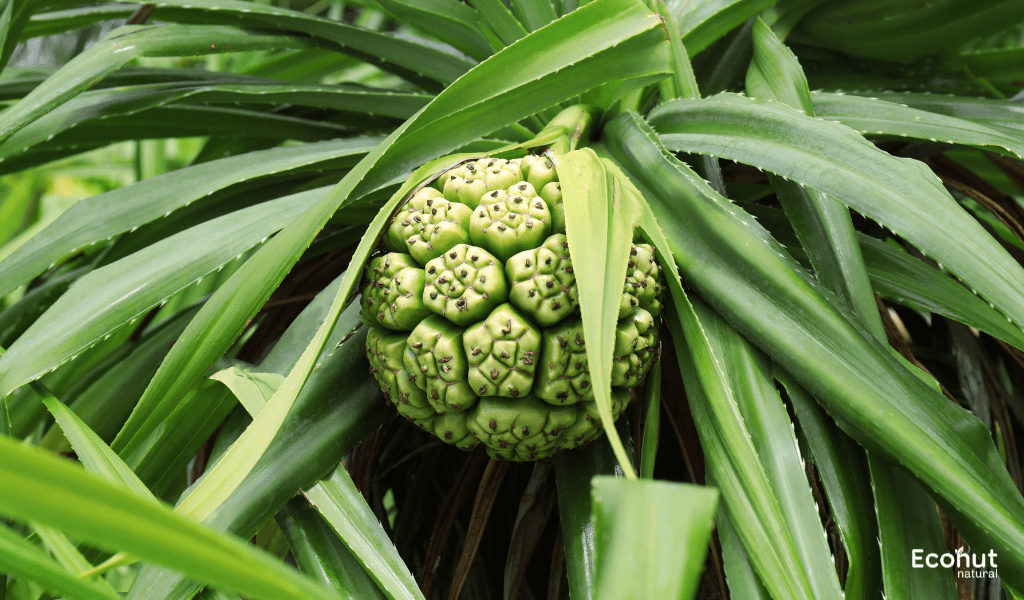Most frequently known as Kewda or Kewra, Ketak (Pandanus odorotissimus) is found primarily in coastal regions of Southeast Asia, which includes northern Australia, Papua New Guinea, Indonesia, and the Philippines. Antiviral, antiallergy, antiplatelet, anti-inflammatory, antioxidant, and anticancer effects are all present in pandanus odoratissimus. It is available online as powder, oil, water, and incense.
Scre pin (Pandanus odorotissimus) can be utilized in a plethora of ways. They may be used fresh or dried, and they are an essential part of keeping our bodies healthy by boosting our immune and promoting mental well-being.
Description
ketak is a member of the Pandanaceae family. This herb tree can reach a height of 3–4 meters and develops rather quickly in a temperate area. It resembles a palm tree. Its Kapha-Pitta Shakkay properties are well known.
Botanical Name:
Pandanus odorotissimus
Family:
Pandanaceae
Leaves:
The leaves grow in stiff clusters that are sword-shaped, 40–70 cm long, and greenish blue in color.
Flowers:
The Ketak plant yields fragrant flowers with a fruity undertone and a sweet, rose-like aroma. These blooms, which are mostly male, are utilized to make the aromatic floral distillate known as kewra water.
Fruits:
The rounded fruits of the ketak grow in bunches. When ripe, they have a deep greenish color and can grow to be quite enormous, measuring between 4 and 10 inches in length and diameter.
Roots:
The Ketak, as was previously described, has an unusual root structure that includes aerial prop roots. These roots extend downward from the plant’s branches and into the ground. They support and stabilize the plant, especially when it’s windy outside.
Habitat:
This plant usually grows around riverbanks, ponds, and seashores. It spreads quickly through seeds or branch cutting. A flower blooms during the wet season, while fruits appear during the summer.
Parts Used:
- Root
- Flower
Dosage:
- Powder – 3 to 5 g
- Distillate – 30 to 40 ml
Chemical Constituents
The main ingredient in Ketak, is made up of methyl ether of beta phenyl ethyl alcohol, benzyl salicylate, terpene-4-ol, and essential oils.
Synonyms
Kakchchad – Its leaves are off with sharp tips and are serrated.
Ketak, Soochipushap – Needles are similar to sharp flowers.
Other Language Names of Ketak (Pandanus odorotissimus)
Hindi name – Kewda
Farsi name – kadi
English name – Screw Pine
Gujarati name – kewado
Bengali name – keya
Tamil name – Jawnaan, Chedi
Telugu name – Mogali chettu
Scientific Classification
| Kingdom | Plantae |
| Family | Pandanaceae |
| Genus | Pandanus |
| Species | P.odorifer |
Ayurvedic Properties
Rasa (Taste) – Tikta (Bitter), Madhur (Sweet), Katu (Pungent)
Guna (Quality) – Laghu (light), Snigadh (Moist)
Vipaka (Post digestive effect) – Katu (Pungent)
Veerya (Potency) – Ushna (hot)
Karma (Action) – Balances the Vata, and Kapha dosha.
Ketak (Pandanus odorotissimus) Uses
- This plant helps treat skin conditions like eczema and pruritus in addition to improving complexion.
- This helps to nourish all of the nerves and calm the mind.
- Its floral juice is beneficial for treating apsmara.
- Ketaki has many uses, including as an anti-epileptic, analgesic, hair conditioner, odor eliminator, and wound or ulcer healer.
- A decoction made from its leaves and its pleasant smell can improve tooth health.
- Diabetes can be effectively treated with roots.
Ketak (Pandanus odorotissimus) Benefits
Skin health:
Ketak (Pandanus odorotissimus) is used to treat skin diseases like eczema and pruritus and to improve complexion.
Pain relief:
As an analgesic and anti-epileptic, ketok is said to help reduce pain and seizures.
Hair health:
Ketak is used to encourage hair development and get rid of body and hair odor.
Heart health:
Ketak is also believed to be good for heart health and act as a heart tonic
Ketak (Pandanus odorotissimus) Side Effects
Potential for drug interactions:
Ketak and several medicines may interfere. Make sure your doctor knows about all the prescriptions you use, including supplements and herbal therapies.
Allergic reactions:
An allergic reaction to any plant, including Ketak, is always a possibility. Should you encounter any adverse reactions while using Ketak, stop using it immediately and seek advice from a healthcare provider.
Read Alsi: Juniper Berry (Juniperus communis) – Properties, Uses, Benefits & Side Effects
Conclusion
The ketaki root is boiled in sesame oil and then applied externally to relieve headaches and joint discomfort. The stigma of Pandanus odorotissimus flowers is boiled in oil and applied as nasal sprays to epilepsy patients experiencing convulsions.
FAQS
What is Ketak (Pandanus odorotissimus) used for?
Ketak is an herb that is a member of the Pandanaceae family and is scientifically known as Pandanus odoratissimus. The herb ketak is used to treat diabetes, fever, joint discomfort, otalgia, recurrently threatening abortions, and mental illnesses.
What is the botanical name of Ketaki flower?
Pandanus odoratissimus
What is the benefit of Ketak (Pandanus odorotissimus)?
The herb ketak is used to treat diabetes, fever, joint discomfort, otalgia, recurrently threatening abortions, and mental illnesses. Pandanus, the main ingredient in ketaki, is made up of methyl ether of beta phenyl ethyl alcohol, benzyl salicylate, terpene-4-ol, and essential oils.

